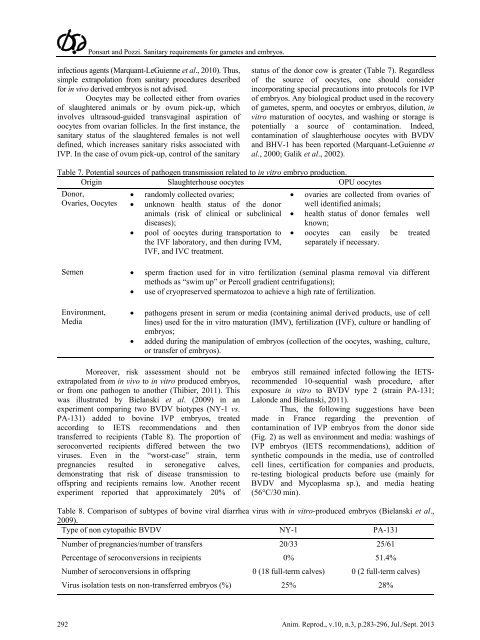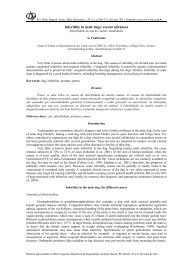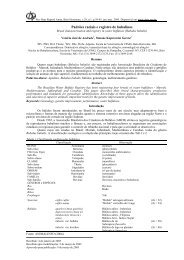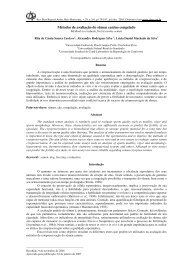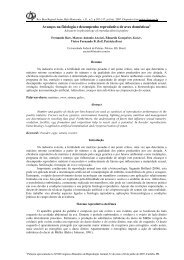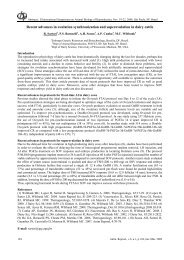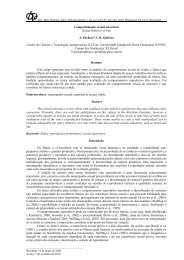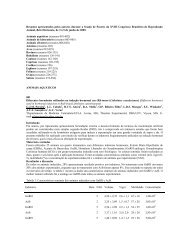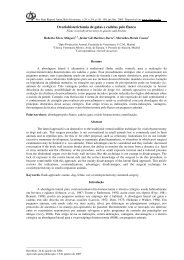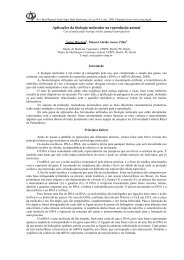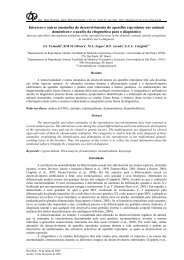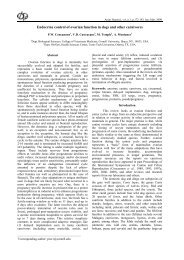Sanitary requirements for bovine gametes and embryos in ... - CBRA
Sanitary requirements for bovine gametes and embryos in ... - CBRA
Sanitary requirements for bovine gametes and embryos in ... - CBRA
You also want an ePaper? Increase the reach of your titles
YUMPU automatically turns print PDFs into web optimized ePapers that Google loves.
Ponsart <strong>and</strong> Pozzi. <strong>Sanitary</strong> <strong>requirements</strong> <strong>for</strong> <strong>gametes</strong> <strong>and</strong> <strong>embryos</strong>.<strong>in</strong>fectious agents (Marquant-LeGuienne et al., 2010). Thus,simple extrapolation from sanitary procedures described<strong>for</strong> <strong>in</strong> vivo derived <strong>embryos</strong> is not advised.Oocytes may be collected either from ovariesof slaughtered animals or by ovum pick-up, which<strong>in</strong>volves ultrasoud-guided transvag<strong>in</strong>al aspiration ofoocytes from ovarian follicles. In the first <strong>in</strong>stance, thesanitary status of the slaughtered females is not welldef<strong>in</strong>ed, which <strong>in</strong>creases sanitary risks associated withIVP. In the case of ovum pick-up, control of the sanitarystatus of the donor cow is greater (Table 7). Regardlessof the source of oocytes, one should consider<strong>in</strong>corporat<strong>in</strong>g special precautions <strong>in</strong>to protocols <strong>for</strong> IVPof <strong>embryos</strong>. Any biological product used <strong>in</strong> the recoveryof <strong>gametes</strong>, sperm, <strong>and</strong> oocytes or <strong>embryos</strong>, dilution, <strong>in</strong>vitro maturation of oocytes, <strong>and</strong> wash<strong>in</strong>g or storage ispotentially a source of contam<strong>in</strong>ation. Indeed,contam<strong>in</strong>ation of slaughterhouse oocytes with BVDV<strong>and</strong> BHV-1 has been reported (Marquant-LeGuienne etal., 2000; Galik et al., 2002).Table 7. Potential sources of pathogen transmission related to <strong>in</strong> vitro embryo production.Orig<strong>in</strong> Slaughterhouse oocytes OPU oocytesDonor,Ovaries, Oocytes• r<strong>and</strong>omly collected ovaries;• unknown health status of the donoranimals (risk of cl<strong>in</strong>ical or subcl<strong>in</strong>icaldiseases);• pool of oocytes dur<strong>in</strong>g transportation tothe IVF laboratory, <strong>and</strong> then dur<strong>in</strong>g IVM,IVF, <strong>and</strong> IVC treatment.• ovaries are collected from ovaries ofwell identified animals;• health status of donor females wellknown;• oocytes can easily be treatedseparately if necessary.Semen • sperm fraction used <strong>for</strong> <strong>in</strong> vitro fertilization (sem<strong>in</strong>al plasma removal via differentmethods as “swim up” or Percoll gradient centrifugations);• use of cryopreserved spermatozoa to achieve a high rate of fertilization.Environment,Media• pathogens present <strong>in</strong> serum or media (conta<strong>in</strong><strong>in</strong>g animal derived products, use of celll<strong>in</strong>es) used <strong>for</strong> the <strong>in</strong> vitro maturation (IMV), fertilization (IVF), culture or h<strong>and</strong>l<strong>in</strong>g of<strong>embryos</strong>;• added dur<strong>in</strong>g the manipulation of <strong>embryos</strong> (collection of the oocytes, wash<strong>in</strong>g, culture,or transfer of <strong>embryos</strong>).Moreover, risk assessment should not beextrapolated from <strong>in</strong> vivo to <strong>in</strong> vitro produced <strong>embryos</strong>,or from one pathogen to another (Thibier, 2011). Thiswas illustrated by Bielanski et al. (2009) <strong>in</strong> anexperiment compar<strong>in</strong>g two BVDV biotypes (NY-1 vs.PA-131) added to <strong>bov<strong>in</strong>e</strong> IVP <strong>embryos</strong>, treatedaccord<strong>in</strong>g to IETS recommendations <strong>and</strong> thentransferred to recipients (Table 8). The proportion ofseroconverted recipients differed between the twoviruses. Even <strong>in</strong> the “worst-case” stra<strong>in</strong>, termpregnancies resulted <strong>in</strong> seronegative calves,demonstrat<strong>in</strong>g that risk of disease transmission tooffspr<strong>in</strong>g <strong>and</strong> recipients rema<strong>in</strong>s low. Another recentexperiment reported that approximately 20% of<strong>embryos</strong> still rema<strong>in</strong>ed <strong>in</strong>fected follow<strong>in</strong>g the IETSrecommended10-sequential wash procedure, afterexposure <strong>in</strong> vitro to BVDV type 2 (stra<strong>in</strong> PA-131;Lalonde <strong>and</strong> Bielanski, 2011).Thus, the follow<strong>in</strong>g suggestions have beenmade <strong>in</strong> France regard<strong>in</strong>g the prevention ofcontam<strong>in</strong>ation of IVP <strong>embryos</strong> from the donor side(Fig. 2) as well as environment <strong>and</strong> media: wash<strong>in</strong>gs ofIVP <strong>embryos</strong> (IETS recommendations), addition ofsynthetic compounds <strong>in</strong> the media, use of controlledcell l<strong>in</strong>es, certification <strong>for</strong> companies <strong>and</strong> products,re-test<strong>in</strong>g biological products be<strong>for</strong>e use (ma<strong>in</strong>ly <strong>for</strong>BVDV <strong>and</strong> Mycoplasma sp.), <strong>and</strong> media heat<strong>in</strong>g(56°C/30 m<strong>in</strong>).Table 8. Comparison of subtypes of <strong>bov<strong>in</strong>e</strong> viral diarrhea virus with <strong>in</strong> vitro-produced <strong>embryos</strong> (Bielanski et al.,2009).Type of non cytopathic BVDV NY-1 PA-131Number of pregnancies/number of transfers 20/33 25/61Percentage of seroconversions <strong>in</strong> recipients 0% 51.4%Number of seroconversions <strong>in</strong> offspr<strong>in</strong>g 0 (18 full-term calves) 0 (2 full-term calves)Virus isolation tests on non-transferred <strong>embryos</strong> (%) 25% 28%292 Anim. Reprod., v.10, n.3, p.283-296, Jul./Sept. 2013


